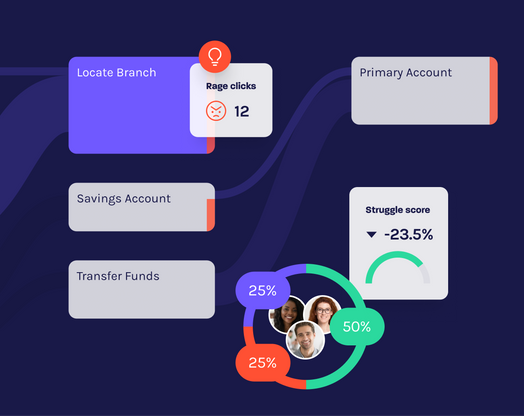
Cyber Weekend shopping plans: Survey says digital experiences matter
Cyber Weekend, one of the busiest shopping periods of the year, is fast approaching. As retailers gear up for this digital shopping extravaganza, understanding consumer preferences and behaviors is paramount for delivering exceptional customer experiences. We polled 1,000 US consumers leading up to Cyber Weekend to find out how they expect to engage with brands and retailers digitally. The data sheds light on evolving consumer trends that will shape this year's holiday retail landscape.
Diverse shopping preferences

Consumers have more options for where, when and how they shop, but unsurprisingly, digital shopping continues to surge. In fact, 63% of consumers prefer digital channels such as apps, websites and marketplaces over in-person shopping experiences (32%). This diversity in shopping preferences highlights the need for retailers to adopt an omnichannel approach. While in-person experiences still retain their charm, the popularity of digital channels suggests a shift towards convenience, variety and competitive pricing. Moreover, consumer interest in brand-specific websites and apps underlies the importance of establishing a strong digital presence that offers unique value propositions and engages customers directly.
Investing in omnichannel strategies that seamlessly integrate in-store experiences with a robust online presence and strategic partnerships with marketplace platforms could prove instrumental in meeting modern consumers' diverse needs and expectations.
Pre-shopping rituals set the stage
The period leading up to Black Friday and Cyber Weekend is now a phase where consumers engage in preparatory activities, shaping their purchasing decisions. Our data reveals an intriguing trend: 72% of consumers are eagerly gearing up for the shopping weekend, stating they are likely or very likely to partake in "pre-shopping" activities online. This pre-shopping ritual entails more than mere browsing, as consumers deliberately scout for deals, explore product offerings and curate wish lists ahead of the sales rush. They are immersing themselves in the digital realm, familiarizing themselves with available choices, comparing prices and eagerly anticipating upcoming deals.
This pre-shopping period is an opportunity for brands and retailers to create an early and memorable experience by offering personalized deals that capture their attention before they intend to purchase. Creating buzz, generating excitement and providing a taste of what's to come can draw customers into the shopping narrative, build anticipation and ensure they're primed and ready to buy when the exclusive deals kick off.
Mobile dominance and convenience factor

The allure of mobile shopping lies in its unmatched convenience—a pocket-sized gateway to a world of products and services. Consumers relish the ease and flexibility of browsing, exploring and purchasing items at their fingertips anytime and anywhere. When done well, mobile apps' seamless and user-friendly interfaces amplify this convenience, providing a frictionless shopping experience. The survey revealed that 60% of consumers preferred mobile apps vs. web platforms due to convenience and that 84% are willing to install and shop through a retailer’s mobile app if it gives them access to better sales or pricing. Undeniably, the stakes to offer a strong mobile shopping experience are high.
Interestingly, 52% of consumers cite a specific reason for their preference for mobile shopping: the ability to save account and cart information. This capability streamlines the shopping process, allowing users to effortlessly pick up where they left off without the hassle of re-entering details or reselecting items. This feature saves time and reduces friction points, fostering a more enjoyable and efficient shopping experience.
Given the rise of mobile shopping, retailers are increasingly pivoting towards mobile-centric strategies. They're investing in optimizing mobile apps for superior performance, user interface enhancements, and implementing features that facilitate account and cart information retention. Such efforts cater to consumer preferences and elevate the overall shopping experience, improving customer satisfaction and loyalty.
Checkout: A make or break moment
The checkout process is the culmination of a customer's journey—the phase where the ultimate outcome of a completed purchase or an abandoned cart is determined. Our survey revealed that during Cyber Weekend, a staggering 50% of Millennials indicate they would abandon their purchase if confronted with any issue during the checkout process. Millennials, a digitally savvy demographic that also holds a lot of purchasing power, have grown accustomed to seamless digital experiences and won’t settle for any friction. Their familiarity with online shopping amplifies their expectations for hassle-free checkout. Any hindrance encountered during this critical stage disrupts the purchasing journey and negatively impacts the overall perception of the brand or retailer.
Mobile app adoption and social media influence

The eagerness of consumers to embrace retailer-specific mobile apps is rooted in the desire for added value—be it in the form of exclusive deals, better pricing options or a more personalized shopping journey. Retailers that can leverage their mobile apps to provide such value propositions stand to attract and retain customers, fostering loyalty and long-term engagement.
Furthermore, the influence of social media platforms on consumer behavior continues to evolve and diversify. The impact of TikTok, known for its viral content and engaging format, varies significantly across generations. While 50% of Millennials acknowledge TikTok's influence on their purchasing decisions, an even more impressive 61% of Gen Z consumers affirm the platform's impact on their buying behaviors.
The differing responses across generations regarding TikTok's influence highlight the need for retailers to tailor their marketing strategies accordingly. Gen Z, known for its digital fluency and penchant for engaging content, is more influenced by TikTok compared to older Millennials.
Comparing expectations to reality
Our pre-Cyber Weekend survey focused on how consumers expect to engage in holiday shopping. But we’re also curious about how those expectations map to their actual shopping behaviors this year. Stay tuned for additional data and in-depth analysis in early December about how consumers’ intentions compared to their actions this holiday shopping season.








